Award of Excellence
Peritoneum
Anna Christy, Student ASLA; Kyle Fiano, Student ASLA and Erica Mackenzie, Assoc. ASLA, Undergraduate, Arizona State University
Faculty Advisor: Kim Steele
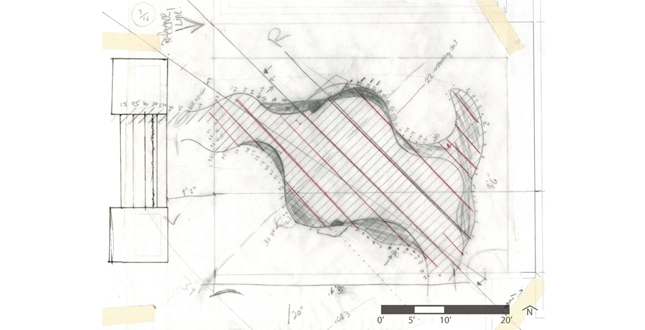 Close Me!
Close Me!Site Plan. From designing to building on-site, we used a working hand drawn site plan to allow for flexibility as we moved forward
Download Hi-Res ImageImage: Tim Trumble and Anna Christy
Image 1 of 15
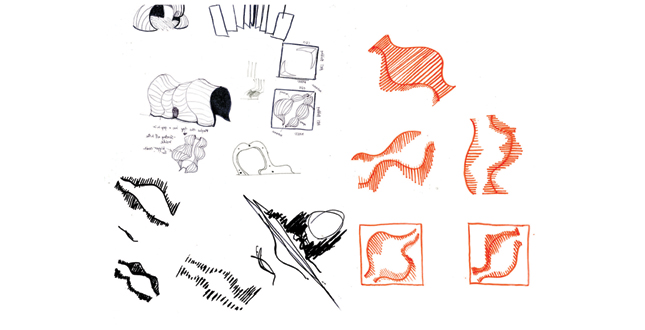 Close Me!
Close Me!Sketches. Each student expressed their own design ideas and, as a team, were discussed and narrowed down to a final design
Download Hi-Res ImageImage: Tim Trumble and Anna Christy
Image 2 of 15
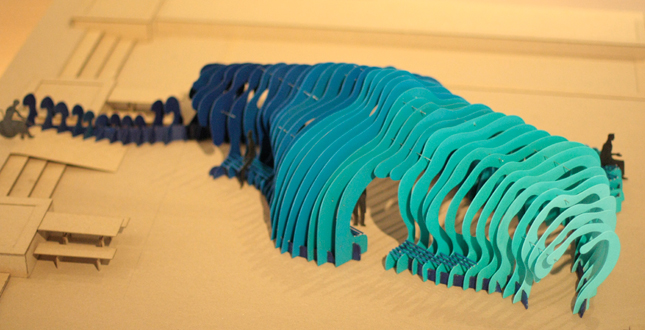 Close Me!
Close Me!Model. Modeling the project was important for spatial relations and construction concerns
Download Hi-Res ImageImage: Tim Trumble and Anna Christy
Image 3 of 15
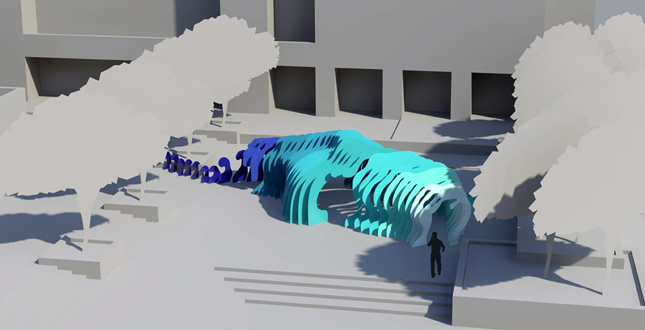 Close Me!
Close Me!Computer Model. Modeling in the computer allowed for any necessary changes
Download Hi-Res ImageImage: Tim Trumble and Anna Christy
Image 4 of 15
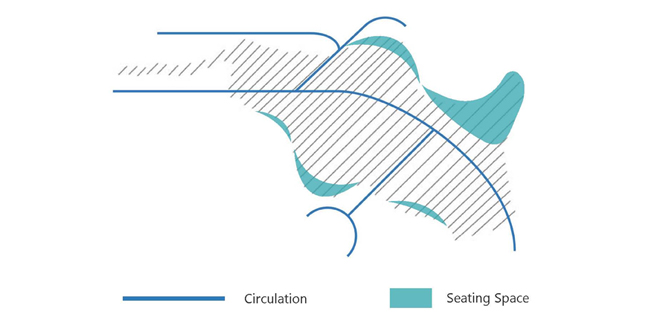 Close Me!
Close Me!Circulation Diagram. Understanding the movement in the space
Download Hi-Res ImageImage: Tim Trumble and Anna Christy
Image 5 of 15
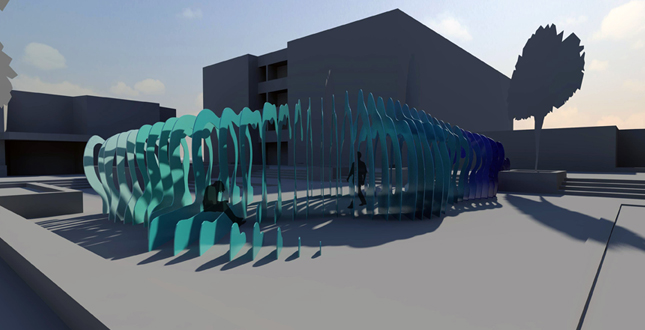 Close Me!
Close Me!Computer Model. Design Integrity
Download Hi-Res ImageImage: Tim Trumble and Anna Christy
Image 6 of 15
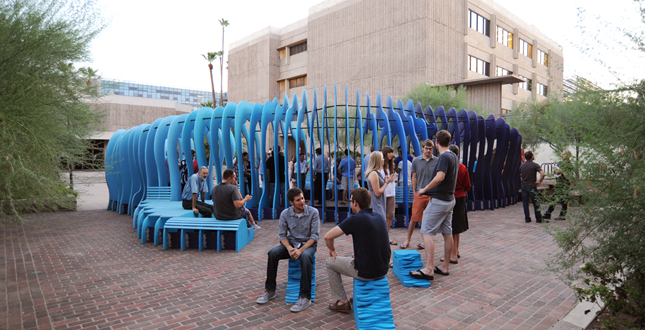 Close Me!
Close Me!Final Built Project. Design Integrity
Download Hi-Res ImageImage: Tim Trumble and Anna Christy
Image 7 of 15
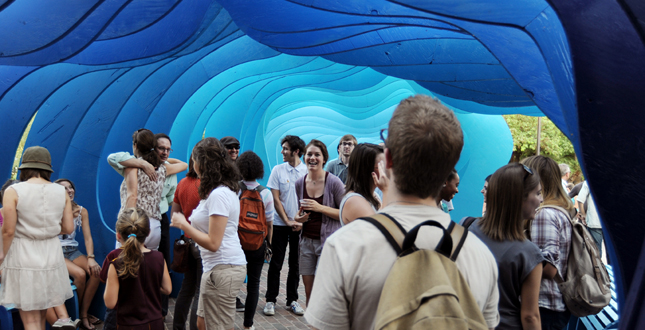 Close Me!
Close Me!Inside Peritoneum. The space offers opportunities for large gatherings and performances
Download Hi-Res ImageImage: Tim Trumble and Anna Christy
Image 8 of 15
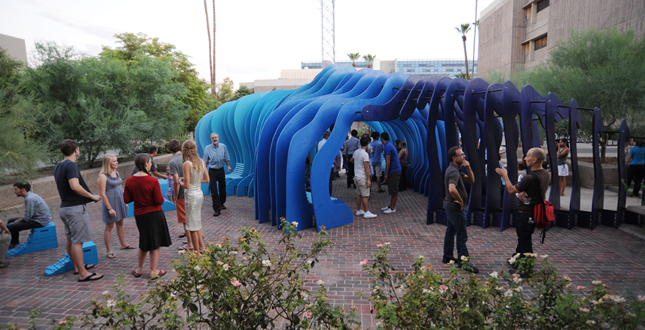 Close Me!
Close Me!North Side. The design engages users in a variety of ways
Download Hi-Res ImageImage: Tim Trumble and Anna Christy
Image 9 of 15
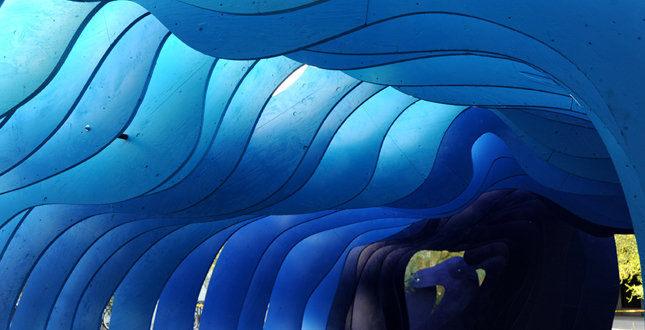 Close Me!
Close Me!Light. Due to the slatted design, the sunlight makes the ribs appear to glow from the outer edge, creating a spectacular display of light and color
Download Hi-Res ImageImage: Tim Trumble and Anna Christy
Image 10 of 15
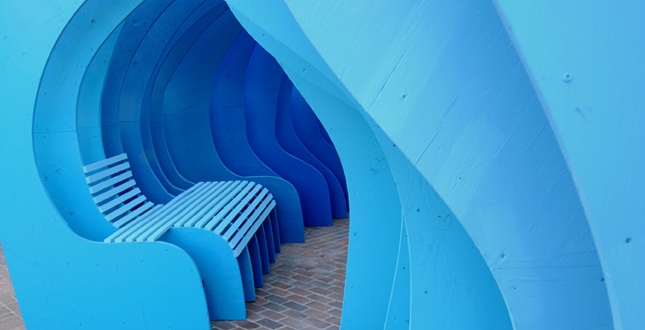 Close Me!
Close Me!Seating. Peritoneum offers inner and outer seats for summer shade and winter sun
Download Hi-Res ImageImage: Tim Trumble and Anna Christy
Image 11 of 15
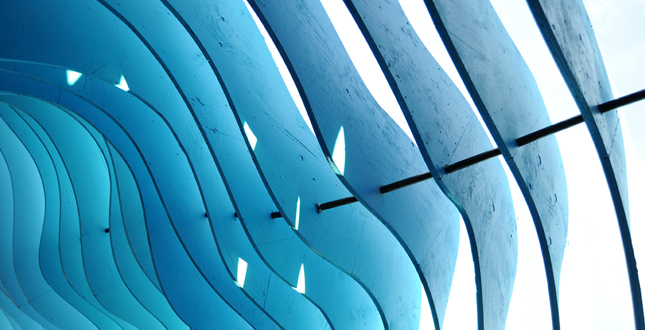 Close Me!
Close Me!Metal Rods. The design’s structure offers maximum support with minimal visual obstruction
Download Hi-Res ImageImage: Tim Trumble and Anna Christy
Image 12 of 15
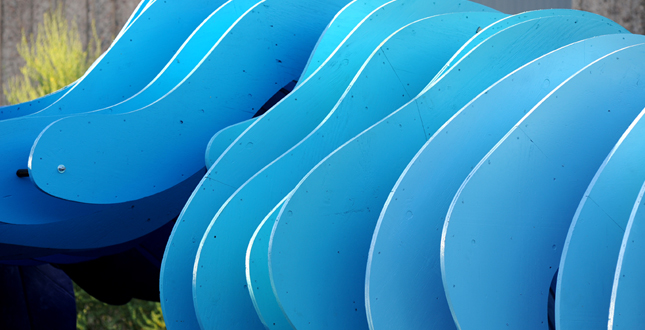 Close Me!
Close Me!Undulations. The undulations in the design creates a unique visual perception that is different from the outside to the inside
Download Hi-Res ImageImage: Tim Trumble and Anna Christy
Image 13 of 15
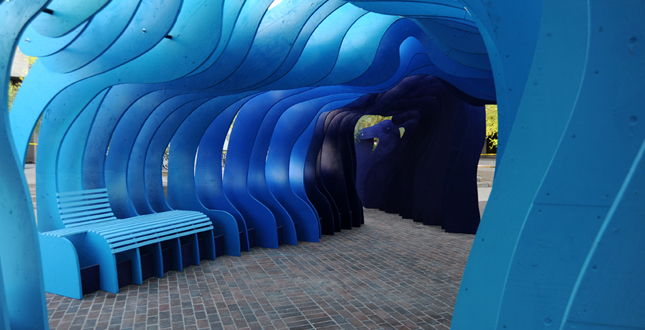 Close Me!
Close Me!Color Gradient. The gradual change in color allows for a feeling of movement in the space even while standing still
Download Hi-Res ImageImage: Tim Trumble and Anna Christy
Image 14 of 15
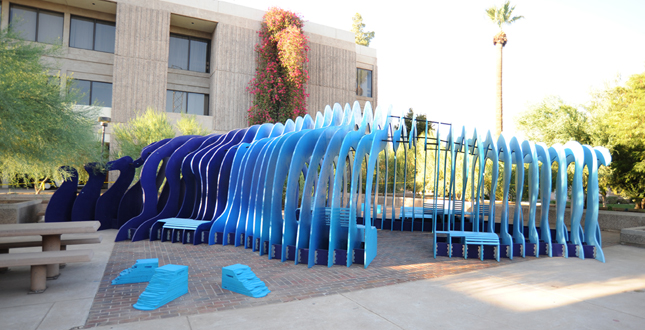 Close Me!
Close Me!South Side. The project is slatted, offering security on the inside while also providing shade
Download Hi-Res ImageImage: Tim Trumble and Anna Christy
Image 15 of 15
Project Statement
Peritoneum reflects the collaboration of interdisciplinary students employing their respective talents to build a temporary shade structure for a plaza space on a university campus. The undulating blue structure evokes a calming, cooling environment, and captivates others by its daring interpretation of typical shade structures. Peritoneum, associated with the ribcage, transforms an underutilized area into an active passageway, place of rest, and ultimately the core adjacent design and art school.
Project Narrative
The project is located on a university campus, and is a temporary shade structure for the campus’ community in the 2011-2012 academic school year. The plaza onto which the structure is placed is located between an active lecture hall, the art school, and the design school. The project "square" is a space of 35 feet by 45 feet. In the past, the plaza itself has been underutilized, and observation has shown that most visitors of the site use it merely as a pathway to and from different buildings.
Our team, Second Story, entered this design competition as a multidisciplinary team, composed mostly of undergraduate Landscape Architecture students, along with students in graphic design, drawing, and dance. The challenge of the project was to create a shade structure that is sustainable, constructible on a limited budget, and has the ability to engage the community, as well as our fellow students. As the winner of the design competition for "X-Square," we were afforded the opportunity to build our structure.
The design process began with preliminary designs by each member individually, allowing each student to interpret the project according to the expertise and talents of their respective major. The sketches ranged considerably from student to student, and we were able to extract the best elements from each design to use in our final piece. This collaboration of individual talents is evident in our final design, with each discipline well represented. We not only strove to create a unique and functional shade structure, but saw an opportunity to create a great art installation as well. Our intent with the design was to enhance the existing circulation pattern and passageway, rather than eliminating or fighting the natural flow. We relied heavily on color to create heightened visual interest and change in perception of space to evoke emotion for the viewer.
As we moved into the post-design phase, we tackled issues just like any other project, meeting ADA standards as well as fire and safety codes. A major constraint was that the design was not to penetrate the ground in any way. Though this brought many challenges, we were determined to keep design integrity throughout the process, letting the people who voted for our design to be satisfied with the outcome. The project, being an overhead structure, needed to be approved by an engineer. We worked closely with a licensed, local engineer, which gave us experience in collaboration and taught us how to communicate our ideas so they would not be lost from design to construction. We collaborated with other professionals for advice (contractors, engineers and wood shop workers) to obtain ideas that would best suit our design. After many meetings, we sifted through all the guidance and narrowed down how we would erect a structure many professionals and professors thought to be impossible, especially with our lack of experience.
Debating many topics such as how to attach each rib and the choice of appropriate paint and sealant, we finalized each component of the design. Every rib was drawn by hand on trace and was then scanned and traced in AutoCAD to be used for the CNC cutter. Each rib would be doubled layered with 5/8” CDX plywood and would be laminated, or have offset pieces, to keep from the need of brackets which would be an eyesore. Each piece from the ribs would be CNC cut off-site then glued, screwed, and painted on-sight. The scrap from the cuts would then be used to create gussets that were placed in between each rib along the base, allowing the ribs to stand erect. Extra wood scrap was also used for movable seating in the space. Metal rods would then be inserted along the top, bending through the undulations of the design and allowing a structural connection to each rib, which gives support and allocates the design to ground itself due to the high mid-point and lower end-points. The project is painted with a self-priming high grade exterior paint that allows protection to the plywood, keeping it from soaking up rain water. The paint also plays a significant role in the visual perception of the space as it gradients shades of blue from one end to the other. The choices that were made have proven to be sufficient as the project has dealt with heavy Arizona rains and winds as well as scorching sun and heat.
Not only has the project been a success to the elements of weather, but of human use and interaction. Peritoneum has proven to be a photography hot spot due to its unusual visual aesthetics as well as amazing play of light, which allows the ribs to appear as if they are glowing in the desert sun. Many people are found sitting in the structure, waiting for class or just taking the opportunity to study or relax. It has become a space for visitors to come and observe the efforts and opportunities at the design and art school as well as become a temporary landmark on campus with nicknames such as the ‘blue whale’, ‘dinosaur’, and ‘giant ribcage’. With use from the community came respect, as the project has only been tagged with graffiti once in the 10 months it has been put up. We are proud of our project, and we are excited that the community shares this pride.
The project has also created much interest outside of the university as a town 25 miles from campus, has offered to purchase the project for their community center. As the project is an annual competition, it must be taken down this summer of 2012. There is much planning taking place in order for a successful move to the town, and it is with great honor to do so, as it will allow our project to live on.
With such an amazing opportunity given to us, we approached the project with ambition and passion to create something outstanding. We strove to uphold our design integrity, understand the safety concerns and construction of the project. We are also satisfied that we accomplished this task $4,000 shy of our $20,000 budget limit and built it on schedule. In the end, we have learned the importance of design in the community and will always be in our hearts and minds as we design in the future.
Additional Project Credits
Additional Team Members
Art Drawing: Courtney Larsen
Visual Communications: Joshua Gallagher
Dance: Erin Giordano
Consulting Structural Engineers: Caruso Turley Scott Inc
Paul Scott
Sherwin-Williams
Heldt Lumber Company, Inc
Cutting Edge Components
The Design School, Herberger Institute for Design and the Arts, Arizona State University





